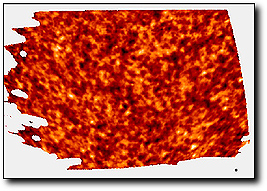 |
|
|
 |
||
|
||||||||||||||
|
This material is available primarily for archival purposes. Telephone numbers or other contact information may be out of date; please see current contact information at media contacts.
Cosmologists Reveal First Detailed Images of Early UniverseAn international team of cosmologists has released the first detailed images of the universe in its infancy. The images reveal the structure that existed in the universe when it was a tiny fraction of its current age and 1,000 times smaller and hotter than it is today. Detailed analysis of the images is already shedding light on some of cosmology's outstanding mysteries -- the nature of the matter and energy that dominate intergalactic space and whether space is "curved" or "flat." The project, dubbed BOOMERANG (Balloon Observations of Millimetric Extragalactic Radiation and Geophysics), obtained the images using an extremely sensitive telescope suspended from a balloon that circumnavigated the Antarctic in late 1998. The balloon carried the telescope at an altitude of almost 37 kilometers (120,000 feet) for 10-1/2 days. The results will be published in the April 27 issue of Nature. Today, the universe is filled with galaxies and clusters of galaxies. But 12-15 billion years ago, following the Big Bang, the universe was very smooth, incredibly hot and dense. The intense heat that filled the embryonic universe is still detectable today as a faint glow of microwave radiation that is visible in all directions. This radiation is known as the cosmic microwave background (CMB). Since the CMB was first discovered by a ground-based radio telescope in 1965, scientists have eagerly sought to obtain high-resolution images of this radiation. NASA's Cosmic Background Explorer (COBE) satellite discovered the first evidence for structures, or spatial variations, in the CMB in 1991. The BOOMERANG images are the first to bring the CMB into sharp focus. The images reveal hundreds of complex regions that are visible as tiny variations -- typically only 100-millionths of a degree Celsius (0.0001 C) -- in the temperature of the CMB. The complex patterns visible in the images confirm predictions of the patterns that would result from sound waves racing through the early universe, creating the structures that by now have evolved into giant clusters and super-clusters of galaxies. "The structures in these images predate the first star or galaxy in the universe," said U.S. team leader Andrew Lange of the California Institute of Technology. "It is an incredible triumph of modern cosmology to have predicted their basic form so accurately." Italian team leader Paolo deBernardis of the University of Rome La Sapienza added: "It is really exciting to be able to see some of the fundamental structures of the universe in their embryonic state. The light we have detected from them has traveled across the entire universe before reaching us, and we are perfectly able to distinguish it from the light generated in our own galaxy." The BOOMERANG images cover about three percent of the sky. The team's analysis of the size of the structures in the CMB has produced the most precise measurements to date of the geometry of space-time, which strongly indicate that the geometry of the universe is flat, not curved. This result is in agreement with a fundamental prediction of the "inflationary" theory of the universe. This theory hypothesizes that the entire universe grew from a tiny subatomic region during a period of violent expansion that occurred a split second after the Big Bang. The enormous expansion would have stretched the geometry of space until it was flat. NASA's National Scientific Balloon Facility was instrumental in flying the giant helium balloon that carried the instruments above the earth's atmosphere. The National Science Foundation (NSF), which provides logistic support for all U.S. scientific operations in Antarctica, facilitated the launch near McMurdo Station and recovery of the payload after the flight. The constant sunshine and prevailing winds at high altitudes in Antarctica were essential to maintaining a stable long-duration balloon flight for the BOOMERANG project. The balloon, with a volume of 800,000 cubic meters (28 million cubic feet), carried the two-ton telescope 8,000 km (5,000 miles) in 10 1/2 days and landed within 50 km (31 miles) of its launch site. The 36 team members are from 16 universities and organizations in Canada, Italy, the United Kingdom and the United States. Primary support for the BOOMERANG project comes from NSF and NASA in the United States; the Italian Space Agency, Italian Antarctic Research Programme and the University of Rome La Sapienza in Italy; and the Particle Physics and Astronomy Research Council in the United Kingdom. The Department of Energy's National Energy Research Scientific Computing Center provided supercomputing support in the United States.
For more information and images on BOOMERANG, see: For background information on scientific research in
Antarctica, see: See also: Fact Sheet on Astrophysics in Antarctica
|
||||||||||||||
|
|
|
|




